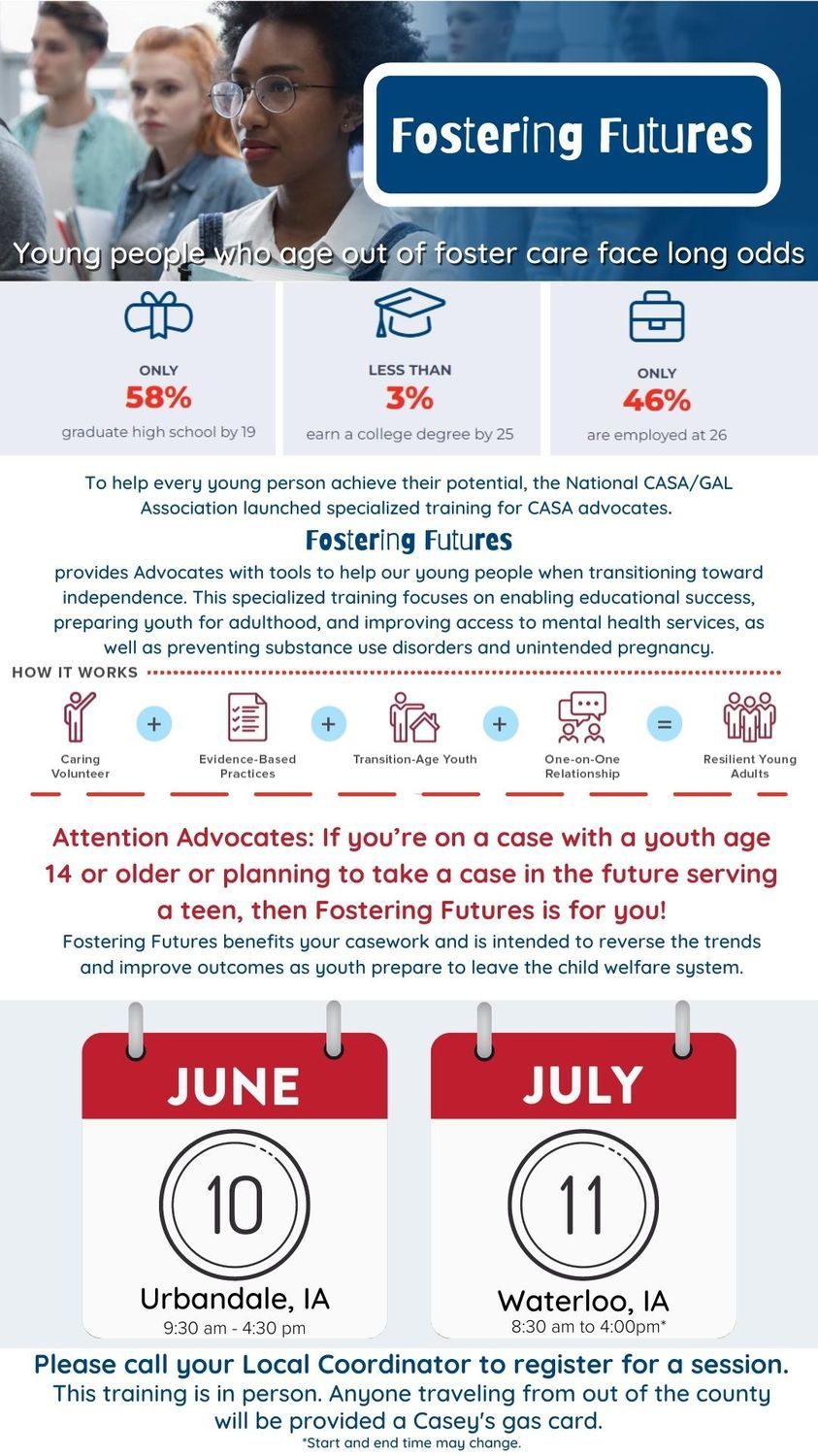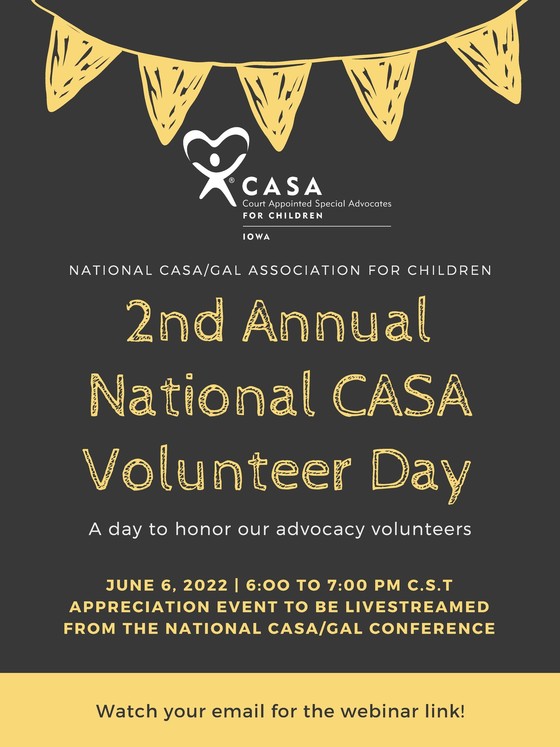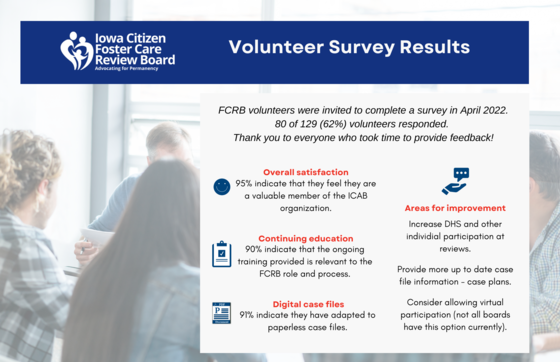
 Welcome to Our New Volunteers!
| Laurie Bartolotta, CASA, Dubuque County |
Laura Bee, CASA, Allamakee County |
| Tina Corley, CASA, Iowa County |
Deborah Dundee, CASA, Cedar County |
| Irith Glessner, FCRB, Linn County |
Nick Huff, CASA, Dubuque County |
| Hope Prentice, CASA, Cherokee County |
Karaline Schulte, CASA, Johnson County |
| Carolyn Weets, CASA, Clinton County |
Brian Wyssman, CASA, Pottawattamie Co. |
Benton-Iowa-Tama FCRB Spotlight
Submitted by Coordinator Teresa Barnes
 Left to right: Bill Sackett (facilitator), Connie McQuiston and Cathy Harvey
Not pictured: Don Logan, Beth Moser, Jeanette Dostal, and Rita Taylor-Stewart
This local board has been active since 1997, serving Benton, Iowa and Tama Counties, and is facilitated by Bill Sackett. The board has adapted to a hybrid model of in-person with some virtual participation by board members and interested parties from time to time. The members of this board are knowledgeable about community resources that may benefit the children and families that come before the foster care review board.
Cathy Harvey worked as a paraeducator from 2006- 2018, assisting junior high and elementary school students with learning/behavior disabilities to maximize academic success. She has adopted children of her own and is familiar with the juvenile court and adoption process. She is an active member in the community, often volunteering her time to help children and families. Cathy shares, "While serving on the TIB foster care review board, I appreciate the opportunity to advocate for children in foster care and for the families who care for them. As a foster/ adoptive mom, I have first hand experience with the frustrations inherent in the system and with the importance of foster care review boards as an avenue to support children and their families."
Connie McQuiston has an AA in Criminal Justice. She has worked with adults with severe mental health limitations/disabilities for over 25 years. During this time, she served on a committee that determined compliance with case plans and facility rules. Connie is an active member in the community, often volunteering her time to help children and families.
Don Logan has served as the board chair for many years. He is a retired teacher with a background in education and counseling at risk youth. His ability to assess situations in a thorough and insightful manner while looking at the “big picture” has been an asset to the review process. Don is involved in other volunteer community organizations such as the Lions Club, the local Food Pantry, and activities through his church. Don was recently appointed to serve on the state board for the Child Advocacy Board.
Beth Moser is married and has raised two children to adulthood. She is employed at the Mercy Medical Center in Cedar Rapids and is involved in other volunteer community organizations. Beth adds, " I believe our work on the FCRB is valuable while we review, oversee and make recommendations. We are another set of eyes and ears to help children and find stable homes. I especially enjoy the cases where the outcomes are great. It is a rewarding experience."
Jeanette Dostal has experience mentoring, training, and developing others. She is a quick learner and an empathetic leader with a servant-leadership style. She volunteers at the local schools, maintains a PTA membership and has served on various committees over the past 15 years. She also had a background in Youth Education Leadership. Jeanette is an active member in the community, often volunteering her time to help children and families.
Rita Taylor-Stewart is a Physician Assistant and has a background in the medical field and counseling. Rita is involved in other volunteer community organizations such as United Way, is the Vice President for the Benton County Community Scholarship Fund, and is involved in activities through her church. After actively serving for many year, Rita currently fills in as a substitute when needed.


For FCRB Members & CASA Advocates: LGBTQ Awareness in Child Welfare

CASA and Foster Care Review Board Members advocate for children and youth’s individualized well-being and safety needs. As you work with young people in child welfare systems, you may work with young people who are lesbian, gay, bisexual, transgender or questioning their sexual orientation or gender identity (LGBTQ) whether you realize it or not. Child welfare professionals, caregivers, and advocates/board members have the duty to serve these young people with competence and compassion. Unfounded myths and stereotypes about LGBTQ people have no place in the child welfare world. The first step toward competent care is to understand basic facts about LGBTQ people and the issues they face.
WHAT DOES “LGBTQ” MEAN? In recent years, it has become common to use the string of letters “LGBTQ” to be inclusive of all individuals and communities who identify as lesbian, gay, bisexual or transgender or who are questioning their sexual orientation and/ or gender identity. There is no right or wrong way to order the letters (e.g., GLBTQ), and some people add additional letters, including “I” for intersex, “Q” for queer, and “A” for non-LGBTQ allies (e.g., LGBTQQIA).
WHAT CAN ADVOCATES/BOARD MEMBERS DO?
Learn terminology. Understand general terms.
Lesbian: A woman who is emotionally, romantically and sexually attracted to other women.
Gay: A man or woman who is emotionally, romantically and sexually attracted to the same gender; some use the term only to identify gay men. The word gay is often preferred over the word homosexual, which has clinical overtones that some people find offensive.
Bisexual: A man or woman who is emotionally, romantically and sexually attracted to both genders. Sometimes the attraction to each gender is equal, while for others there may be a preference for one gender over the other.
Transgender: An umbrella term used to describe people whose gender identity, one’s inner sense of being male or female, or gender expression differs from the sex assigned to them at birth. It is not dependent upon having sex reassignment surgery. A person’s genital status, whether one has had surgery or not, does not determine that person’s gender for the purpose of social behavior, service provisions, or legal status.
Gender-nonconforming: When a person’s gender expression, the outward communication of gender through behavior or appearance, differs from expectations associated with the sex assigned to them at birth. Transgender girls are people who were assigned the sex of male at birth but identify as female. Transgender boys are people who were assigned the sex of female at birth but identify as male.
Everyone has both a sexual orientation and a gender identity. Gender identity is different from sexual orientation. See below. Transgender people may identify as heterosexual, lesbian, gay, bisexual or questioning. Transgender people may need specialized health care to assist with their gender transition.
Questioning: A person, often an adolescent, who has questions about his or her sexual orientation or gender identity. Some questioning people eventually come out as LGBT; some don’t.
Understand the differences in the acronym SOGIE: Sexual Orientation, Gender Identity and Gender Expression.
Sexual Orientation: The gender of the person to whom someone is attracted emotionally, romantically, sexually, and intimately. Sexual orientation exists on a continuum and is NOT necessarily congruent with behavior. Examples of sexual orientation include lesbian, gay, bisexual, or heterosexual. Sexual orientation involves a process of discovery over time. It is not a volitional choice.
|

Gender Identity: The gender with which someone identifies, regardless of the biological sex label assigned at birth. Gender identity is a psychological sensing of one’s gender, whereas biological sex refers to biology and includes male, female, and intersex, (i.e., having some biological characteristics of both male and female). Examples of gender identity may include: man, woman, or gender queer (i.e., does not identify with any gender label). Gender identity is expressed in a range of ways: such as dress, behavior, speech, appearance, among others. Nonconforming gender behavior in children can be confusing to everyone and may or may not reflect the person’s gender identity or sexual orientation. Click here to see larger image of Genderperson.
Gender Expression: The external representation of one’s gender identity through how one presents or communicates their gender to others. Gender expression may be congruent or incongruent with someone’s gender identity.
Use inclusive language. Most of our language assumes heterosexuality. How many adults would not think twice about asking an adolescent male, "Do you have a girlfriend?" This question will impose a significant dilemma for any LGBTQ youth. The question assumes a heterosexual orientation. A more inclusive LGBTQ question would be: "Is there anyone special in your life or anyone you feel attracted to?" This allows for a wider range of client responses. (It is important for the advocate/board member to mirror the terms and language of the youth when exploring these issues).
Be aware that LGBTQ youth are in out-of-home care in disproportionate numbers. Approximately 5–10% of the general population is lesbian, gay, bisexual or transgender. Research shows that young people facing family rejection, harassment and school failure are more likely to enter the child welfare and juvenile justice systems. According to a 2019 study, more than 30% of youth in foster care identify as LGBTQ. Because many LGBTQ young people face disapproval and overt rejection from their families, they are more likely to be forced from their homes into the foster care and homeless populations. Once in foster care, bias against them may make it harder to find permanent placements for them, prolonging their stay in child welfare systems.
Protect the privacy of the youth. Even if they are open with you and others about his/hers/their sexual orientation and identity, the youth should always be the gatekeeper of this information. Never ‘out’ the youth without their consent.
As an Advocate/Board Member, recognize their risk of self harm. Suicide is the 2nd leading cause of death among young people ages 10 to 24. LGBTQ youth are almost four times as likely to have attempted suicide compared to heterosexual youth. Of all the suicide attempts made by youth, LGBTQ youth suicide attempts were almost five times as likely to require medical treatment than those of heterosexual youth.. Except taken from the Trevor Project www.thetrevorproject.org
|

Connect yourself and the youth with additional resources. Learn more about resources available and share these with the youth and if appropriate, with other caring adults in the youth’s life. Advocate for the youth to be connected with support groups or student organizations that allow them to interact with other LGBTQ youth.
Material taken from the Lambda Legal and Child Welfare League of America’s toolkit, Getting Down to Basics: Tools to Support LGBTQ Youth in Care.
For more on information on ways to advocate for LGBTQ youth, download these Judicial Bench Cards:
|

If you would like to formally learn more about advocating for youth whom identify as LGBTQ, ask your Local Coordinator how you can participate in one of our LGBTQ Youth Advocacy in-service trainings.
The 2022 ICAB Speaker Series
To support your continuous learning journey within our organization and your advocacy efforts as a CASA or FCRB volunteer, please consider attending our upcoming learning session!
AMP: Achieving Maximum Potential. Giving Older Youth a Voice Learn more about the benefits older youth receive from participating in AMP. Terri Bailey, Program Coordinator, will share information on programs and services offered to youth through AMP, upcoming youth events, and how to support older youth in connecting to their local councils. June 23, 2022 3 - 4 pm. Click here to register! As this session will be recorded, please only register to attend the live session.
|
|